Being with friends and family may be a positive experience for some voles but it is merely tolerable to others, suggests a study published today in eLife.

Credit: Beery Lab
Being with friends and family may be a positive experience for some voles but it is merely tolerable to others, suggests a study published today in eLife.
The findings hint at what goes on in the brain of voles when different types of relationships are formed and shows that social motivations may vary by individual, sex and species. As similar hormones and brain structures are involved in social interactions in many species, including humans, this new information may lay the groundwork for better understanding some of the foundations of social differences.
Voles make good model animals for studying social behaviors because they are naturally social creatures. Some vole species, such as prairie voles, form lasting social bonds with both their mates and same-sex peers. Meadow voles, on the other hand, only form communities to help survive the winter and then part ways in the warmer months.
“We wanted to determine why voles of these two species spend time in social contact,” says first author Annaliese Beery, who directed this research in her laboratory at Smith College in Northampton, Massachusetts, US, and is currently in the Department of Integrative Biology at the University of California, Berkeley, US. “Specifically, we wanted to know what role social motivation plays in their behaviour, or to what extent social selectivity is more about avoiding strangers.”
To answer these questions, Beery and her colleagues trained both prairie voles and meadow voles to push a bar to receive food as a reward. They then replaced food rewards with brief access to a familiar vole of the same species, or a stranger, to see how often the voles would push the bar to get close to the other animal. With each successive press of the bar, it became more difficult to gain access to the other vole, with the animals needing to press the bar again for more access.
“There were striking species and sex differences in who the voles would work to be closer to,” Beery says. Her team found that female prairie voles worked harder to see familiar voles than strangers, but male prairie voles did not show this preference for their acquaintances. Instead, the males worked hard to access any females, but showed less interest in males. But the males still huddled with familiar animals when they were together. The meadow voles, which were female only, did not work as hard as the female prairie voles to reach familiar animals.
Together, the results suggest that prairie voles find social interactions with familiar animals rewarding, while the meadow voles were more likely to tolerate friends and family over unfamiliar animals but were not highly motivated by these interactions.
Finally, the researchers discovered that the individual variation in behaviour was associated with the density of receptors in the brain for oxytocin – a hormone linked to social interaction. Animals with more oxytocin receptors in a part of the brain called the nucleus accumbens worked harder to socialise. By contrast, animals with more oxytocin receptors in a part of the brain called the bed nucleus of the stria terminalis were more likely to be aggressive towards other animals.
“Our study illustrates the difference between social reward and social selectivity,” says co-author Sarah Lopez, who worked on the study as a student researcher in the Beery Social Neuroendocrinology Lab at Smith College, and is now a medical student at the University of Pittsburgh, US. “We’ve shown that selectivity can come from avoidance and lack of avoidance, as well as from social reward.”
Beery adds: “Knowing more about how the mechanisms supporting social relationships are similar and different across species and sexes will help us understand which mechanisms are universal and which are species-specific. This insight may in turn aid our understanding of how species-typical patterns of social behaviour might evolve over time.”
##
Media contact
Emily Packer, Media Relations Manager
eLife
+44 (0)1223 855373
About eLife
eLife is a non-profit organisation created by funders and led by researchers. Our mission is to accelerate discovery by operating a platform for research communication that encourages and recognises the most responsible behaviours. We aim to publish work of the highest standards and importance in all areas of biology and medicine, including Neuroscience, while exploring creative new ways to improve how research is assessed and published. eLife receives financial support and strategic guidance from the Howard Hughes Medical Institute, the Knut and Alice Wallenberg Foundation, the Max Planck Society and Wellcome. Learn more at https://elifesciences.org/about.
To read the latest Neuroscience research published in eLife, visit https://elifesciences.org/subjects/neuroscience.
Journal
eLife
DOI
10.7554/eLife.72684
Article Title
Social selectivity and social motivation in voles
Article Publication Date
2-Nov-2021




